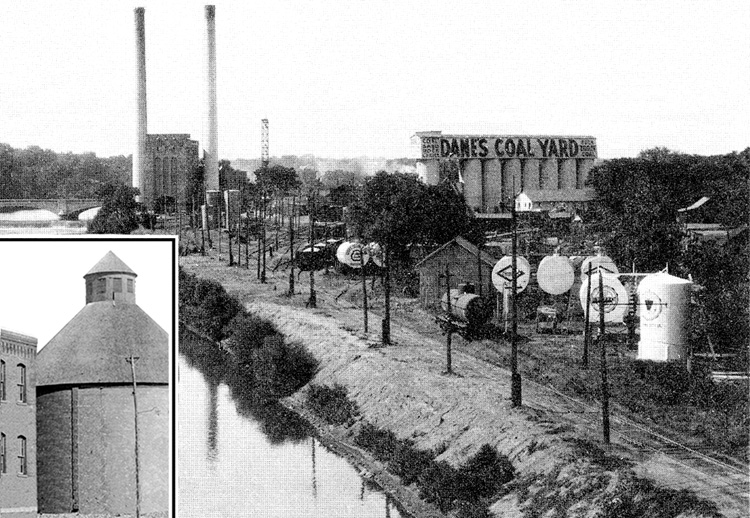
| JOHNSON COUNTY IAGenWeb Project |
Copyright 2003
By Bob Hibbs
Saturday,
March 6, 2004

A
“gas house” used to make coal gas shows over a 1940s image of Dane’s Coal
Yard located along Burlington Street
adjacent to the University of Iowa power plant beside the Iowa River. The
collage was created by the author.
|
By
Bob Hibbs
The
sources of heat and lighting in Iowa City date to a wood market along Iowa
Avenue opened soon after Iowa City was founded in 1839, but within two decades
coal was beginning its eventual replacement as a heat source, both in homes and
commerce.
The
Dane Coal silos along Burlington Street just east of the river were a prominent
feature of the local skyline for nearly 40 years. Demolished in 1966, they were
built in 1927 as a huddle of five-story-tall cylinders, each 16 feet in
diameter, all topped by a roofed canopy of conveyors.
Dane
advertised itself as having “the best coal by a dam site,” referring to the
Burlington Street dam.
There
were a dozen local coal suppliers 75 years ago who shipped it in by train from
as near as What Cheer, although many counties in the southern third of Iowa
produced coal at one time. Not a single supplier remains in the county, nor is
the resulting soot and smoke any longer apparent.
For
lighting, Iowa City pioneers used home-made tallow candles. In Old Capitol,
candles were stored on straw in small boxes hung in hallways. The bed of straw
helped maintain candle shape.
An
early candle factory was an 1856 Close family operation in a little wooden shack
along Ralston Creek just north of what are now the Iowa Interstate Railroad
tracks, formerly the Rock Island line.
Production
of coal gas for lighting began locally in 1857, touted as the first such plant
in Iowa. It began as Iowa City Gas Co., later part of Iowa-Illinois Gas &
Electric Co., a company now owned by Mid-America Energy.
The
gas works were located along Ralston Creek in the southeast quadrant of the
intersection of Burlington and Van Buren streets, which now serves an apartment
complex.
At
peak, 14 furnaces (called “retorts” in an industry which still produces fuel
in some localities today) heated coal to 1,800 degrees. Kept hot for six to
eight hours, the coal emitted gas which accumulated in tanks for later
distribution through a piping system to customers.
The
resulting tar sometimes was mixed into street and sidewalk surfacing; coke was
sold for heating.
Medicinal
use also brought children with whooping cough and others with breathing
difficulties to the “gas house” to breathe the fumes for their supposed
curative power, which apparently brought temporary relief to some.
Three-eighths-inch
coal gas pipe still can be found in some old Iowa City homes, as well as at the
Masonic Building downtown. Built in 1914, it was outfitted with both coal gas
and electrical systems.
It
is unclear why both systems were installed, although both apparently were used
for a time. Gas fumes from a two-story-high third-level meeting hall rose into
the attic through four wooden ceiling grates and out through louvered breather
vents in the roof.
The
1,050-seat Coldren Opera House was a local showplace for coal gas lighting when
opened in 1877. All of its light was provided by 67 gas jets plus seven
double-globe fixtures, reportedly to the astonished delight of patrons.
That
same year, the first two gas lights were installed on either side of the walk
leading to Old Capitol.
An
1883 record shows that the city paid $3,600 annually for 115 street lamps to the
coal gas operation then owned by J.K. Graves & Co. of Dubuque. This was in
addition to 60 kerosene lamps the city council ordered installed in 1879 “on
the outskirts of the city,” apparently meaning beyond the reach of the gas
system.
Coal
gas production ended locally with arrival in 1936 of a natural gas pipeline
providing a cleaner and safer-to-use fuel. The change is not regrettable.
Next
Saturday: Local public schools bloom
during the 1850s. Bob Hibbs collects local postcards and researches history related to them.
|